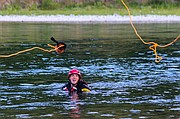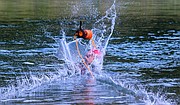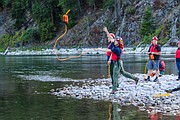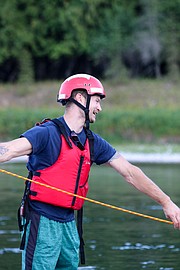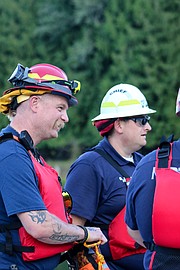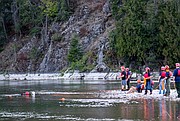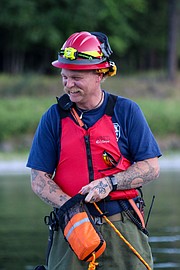For water rescues, practice makes perfect
BONNERS FERRY — Saving a victim from the water takes crucial timing from the rescuers. With many bodies of water, including the Kootenai and Moyie rivers, in Boundary County, it is just a matter of time before first responders, made up of many volunteers, may be called upon to help — and they need to be ready.
North Bench Fire, Boundary Search and Dive Rescue, and Boundary Ambulance met on Thursday, Aug. 22, at the Twin Rivers Resort to practice basic water safety and throw bag training.
The concept was basic, but important for the first responders to practice, or brush up on skills, revolving around a throw bag.
The throw bag is a bag filled with a rope that is made up of a material that floats. The bags are brightly colored for the victim to see easily in the water. The bag itself is thrown to the victim while the rescuer holds onto the end of the rope.
The successful use of a throw bag takes practice, not only to be able to reach a potential victim, but also to gauge a victim rate of travel if being swept down a river, and to throw the bag accordingly.
“We’re doing some shore-based water rescue in the Kootenai River,” said North Bench Fire Chief Gus Jackson from the shore of the river. “We are grateful that Search and Rescue came out to help us — help with some techniques and be the victims.”
Boundary Search and Dive Rescue Commander Tony Jeppesen and Vice Commander Pat Bennett played the part of the victims in repeated scenarios, allowing the first responders to practice the different positions along the river, and hone their skills with a throw bag.
Besides playing the victim role, Jeppesen and Bennett were also able to give some advice and tips to the first responders based on their training and experience.
“We just shared some basic knowledge with them,” said Jeppesen. “It was excellent and both Search and Rescue and North Bench personnel benefited from the training.”
The demonstration ended with a scenario of an unconscious or dead victim, played by Jeppesen.
“What is going to happen is that I am going to go into the water. I am going to be unresponsive. Pat is going to come out and swim to me. Pat is going to get tired, and you guys are going to have to help him,” explained Jeppesen to the first responders.
“Tony will come floating down and I am going to go out and retrieve him,” Bennett said. “Once I have him, I will say ‘bag.’ then someone needs to start tossing a bag to me.”
With everyone in place, from spotters to watch upriver for boats, to multiple people down river to throw bags, the scenario unfolded, resulting in a successful rescue.
“It is great information for all first responders to have basic water safety training,” said Jeppesen, “because they are likely to be working in operations around a waterway.”
At the end of the day, the first responders left with more confidence in their skills — and better ability and potential to possibly save a life if the need arises.













